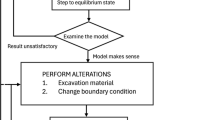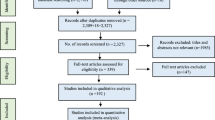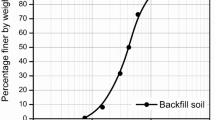Abstract
In all kinds of tunnel excavations, especially those excavated in cities, it is important to control surface settlements and prevent damage to the surface and subsurface structures. For this purpose, in weak rocks and soils, the umbrella arch method (UAM) has been used in addition to the new Austrian tunneling method (NATM). NATM and UAM are the best-known classical methods used in tunnel excavation. In classical tunneling, NATM is usually preferred in normal rocks. However, in some cases, NATM may be insufficient. UAM is a very effective alternative especially in soils and weak rocks. In soil and weak rocks, UAM is especially necessary to prevent excessive deformations. Selection of UAM or NATM is based on the following factors: cost comparison of NATM and UAM, allowable deformations, quality of rock or soil, application time of NATM and UAM, availability of skilled workers, and qualification level of the workers. Therefore, selecting the excavation method in these kinds of grounds is vital in terms of achieving the project goals in time, managing the project costs effectively, and controlling the probable deformations on nearby structures. A critical issue in successful tunneling application is the ability to evaluate and predict the deformations, costs, and project time. In this paper, application times, costs, and deformation effects are compared between NATM and UAM in sensitive regions at the Uskudar-Umraniye-Cekmekoy metro project (UUCMP). Also, efficiency of the deformation control of UAM is demonstrated by using the 2D numerical analysis method. UUCMP is part of the Istanbul metro network. The tunnels have a cross section of 75.60 m2 for NATM and 83.42 m2 for UAM. Geology in this section is composed of weak sandstone. Diabase and andesite dykes are also rarely observed. This study shows that the construction cost of UAM are 1.7 times more expensive than NATM. Although application time of UAM is 2.5 times longer than NATM, it is 2.5 times more efficient in controlling the deformations. This efficiency in controlling the deformations is confirmed via two-dimensional numerical analyses.
















Similar content being viewed by others
References
Aksoy CO, Onargan T (2010) The role of umbrella arch and face bolt as deformation preventing support system in preventing building damages. Tunn Undergr Space Technol 25(5):553–559
Carrieri G, Fiorotto R, Grasso P, Pelizza S (2002) Twenty years of experience in the use of the umbrella-arch method of support for tunnelling. In: International Workshop on Micropiles, Venice
Gangale G, Corona G, Pelizza S (1992) The Messina-Palermo motorway: complex rock masses and tunneling problems. In: Proceedings of the international congress towards new worlds in tunneling, Acapulco, vol 2, pp 873–880
Haruyama K, Teramoto S, Harada H, Mori M (2001) Construction of urban expressway tunnel with special large cross-section by NATM Metropolitan Inter-city Highway (ken-O-Do) Ome Tunnel. In: Proceedings of international symposium, Modern Tunnelling Science and Technology 693–698
Hisatake M, Ohno S (2008) Effects of pipe roof supports and the excavation method on the displacements above a tunnel face. Tunn Undergr Space Technol 23(2):120–127
Hoek E (1998) Tunnel support in weak rock, Symposium of Sedimentary Rock Engineering, Taipei, Taiwan
IMM (2012) Unpublished technical report (in Turkish)
IMM (2013) Uskudar-Umraniye-Cekmekoy metro project, Cakmak station geotechnics report (in Turkish)
Jong HS, Yong KC, Oh YK, Sang DL (2008) Model testing for pipe-reinforced tunnel heading in a granular soil. Tunn Undergr Space Technol 23(6):241–250
Kamata H, Mashimo H (2003) Centrifuge model test of tunnel face reinforcement by bolting. Tunn Undergr Space Technol 18(2–3):205–212
Kim SH, Baek SH, Moon HK (2005) A study on the reinforcement effect of umbrella arch method and prediction of tunnel crown and surface settlement. In: Erdem, Solak (Eds.), Underground space use: analysis of the past and lessons for the future, pp 245–252
Lunardi P (2000) The design and construction of tunnels using the approach based on the analysis of controlled deformation in rocks and soils. Tunnels and Tunnelling International—Supplement (May), 1–30
Murata M, Okazawa T, Harunaka K, Tamai A (1996) Shallow twin tunnel for six lanes beneath densely residential area. North Am Tunn 96:371–380
Ocak I (2008) Control of surface settlements with umbrella arch method in second stage excavations of Istanbul Metro. Tunneling and Underground Space Technology 23(6):674–681
Ocak I (2009) Environmental effects of tunnel excavation in soft and shallow ground with EPBM: the case of Istanbul. Environmental Earth Science 59(2):347–352
Ocak I, Moroy K (2006) Control of surface settlements with umbrella arch method in second stage excavations of Istanbul Metro. Dumlupınar University of Science and Technology Journal 12:79–94 (in Turkish)
Ocak I, Selcuk E, Namlı M, Eker H (2015) Cost comparison of NATM and umbrella arch method, ITA WTC 2015 Congress and 41st General Assembly, May 22–28, Dubrovnik, Croatia
Peila D, Oreste PP, Pelizza S (1996) Study of the influence of sub-horizontal fiber-glass pipes on the stability of a tunnel face. Proc. Int. Conf. on North American Tunneling, Washington, 425–431
Plaxis 2D (2012) ed. Brinkgreve, R.B.J. ve Broere W., Delft University and Technology, Delft-Hollanda
Sekimoto H, Kameoka Y, Takehara H (2001) Countermeasures for surface settlement in constructing shallow overburden urban tunnels penetrated through active fault. In: Adachi et al.(eds.), Proceedings of modern tunneling science and technology, pp 711–716
Selcuk E (2016) Comparing of NATM and umbrella arch method in terms of times, cost and deformation, Istanbul University Master’s thesis (in Turkish)
Shin HS, Han KC, Sunwoo C, Choi SO, Choi YK (1999) Collapse of a tunnel in weak rock and the optimal design of the support system. Proceedings of the Ninth International Congress on Rock Mechanics, Paris
Shin JH, Choi YK, Kwon OY, Lee SD (2008) Model testing for pipe-reinforced tunnel heading in a granular soil. Tunn Undergr Space Technol 23(3):241–250
Yoo CS, Shin CS (1999) Behavior of tunnel face pre-reinforced with sub-horizontal pipes. Int. Symp. Geotechnical Aspects of Underground Construction in Soft Ground, Tokyo, 345–350
Yoo C, Shin HK (2003) Deformation behavior of tunnel face reinforced with longitudinal pipes laboratory and numerical investigation. Tunn Undergr Space Technol 18:303–319
Zhang C, Yang CM, Zuo YJ (2000) Study of construction parameters of horizontal pipe roof in soft ground. J China Coal Soc 25(6):607–609
Acknowledgements
This study was supported by the Scientific Research Projects Coordination Unit of Istanbul University, Project Number 24410 and 38014. The authors are grateful to the Istanbul Metropolitan Municipality for supplying the data.
Author information
Authors and Affiliations
Corresponding author
Rights and permissions
About this article
Cite this article
Ocak, I., Selcuk, E. Comparison of NATM and umbrella arch method in terms of cost, completion time, and deformation. Arab J Geosci 10, 177 (2017). https://doi.org/10.1007/s12517-017-2938-8
Received:
Accepted:
Published:
DOI: https://doi.org/10.1007/s12517-017-2938-8




